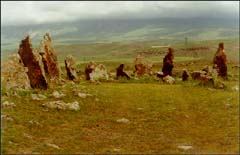|
Three alleys
of stones lie off the central shape, looking like arms reaching
to the North, South and Southeast. The alleys are two
to ten meters wide, with additional stones lying in their path.
These "arms" are important, since the stones with apertures
in them lie only on the alleys.
The North
and South arms bend at the end to the West. "The North
alley is 172 meters long, turning West for another 40 meters.
It holds 71 main stones, 43 with apertures. The South
alley stretches 160 meters, turning west for 40 meters.
It holds 69 main stones, 27 with apertures. The one going
southeast stretches 20 meters, with three main stones inside
the alley."
Though the
exteriors of the stones are rough and lichen covered, the holes
are still polished and finely cut, measuring between 5-7 cm
in diameter. And these apertures are the key to
the entire site. They are actually very accurate telescopes
that point to sunrises and sunsets at specific times of the
year. Lying only in stones on the arms of the complex,
each points to a different point on the horizon.
Herouni's
team measured each one and looked for clues of how they might
have been used. "The eye-holes measure 7 to ten centimeters
diameter at the surface, then funnel down to 5 centimeters in
diameter before opening up again on the other side. The
stones themselves resemble animal shapes, but they are rough
cut, nothing looks refined or interesting. But every one
of the apertures are polished on the inside. When
we took our instruments and looked at the azimuths through them,
we found they were very accurate."
How
accurate? Herouni sketches out a schematic of England's
Stonehenge, pointing to two inner circles inside the mammoth
stones most people think as the monument itself. "Those
huge 'doors' that everyone thinks is Stonehenge are nothing
without these smaller stones in the middle," Herouni says as
he points to a circle of lower stones on his drawing.
"These are the sight stones for the complex. You stood
behind them, then you placed a pole in one of these holes in
the ground between them and the door ways. That's the
only way you could spot something in the sky. There are
many of these stones and holes, so Hawkins thinks the astronomers
rotated around the circle to keep up with the moving sun and
moon."
 The
stones at Sissian are completely different. "Of all the
henges discovered, none have apertures. None. And
the apertures are so cleanly cut, they pinpoint very small spots
in the sky. At Stonehenge your field of vision is much
larger, the door ways are about 70 centimeters wide. But
at Sissian, they are only 5 centimeters diameter. You
can pinpoint a spot within a spot. It is extremely accurate.
Even more so when you think they might have made cornices from
clay or wood and placed them inside the apertures. It
would have made the telescopes amazingly accurate for that time.
Even for today." The
stones at Sissian are completely different. "Of all the
henges discovered, none have apertures. None. And
the apertures are so cleanly cut, they pinpoint very small spots
in the sky. At Stonehenge your field of vision is much
larger, the door ways are about 70 centimeters wide. But
at Sissian, they are only 5 centimeters diameter. You
can pinpoint a spot within a spot. It is extremely accurate.
Even more so when you think they might have made cornices from
clay or wood and placed them inside the apertures. It
would have made the telescopes amazingly accurate for that time.
Even for today."
Wafer thin
obsidian glass uncovered at the site led some to suggest that
an optical insert may have been placed inside the holes
for magnification. "Perhaps," says Herouni, "but no one
has uncovered anything like an insert, so it remains to be seen.
I did find a piece of obsidian that had been ground to a sharp
point at one end. It looks to me it was used to etch with.
What, we never found out."
|